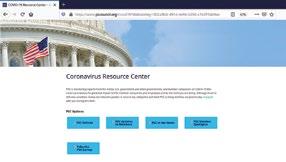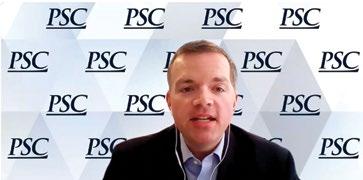Developing a Culture of Resilience to Successfully Manage the Next Crisis by Jeff Treffinger, Senior Vice President of Environmental, Health and Safety (EHS), Amentum
A
s we progress through various stages of reopening, more people are returning to the workplace. There has been much discussion both within government and within the government contracting community about when and how to reopen offices, and how to best protect workers as they return. Some workers, particularly those supporting critical missions in government and in the private sector, continued to work safely throughout the early months of the COVID-19 pandemic. What enabled these organizations to continue the mission without seeing outbreaks among their workers? What lessons can we take away from this experience as we prepare for the next crisis? To answer these questions, we must first define what success looks like.
What defines success?
Practice how you fight
Our military partners know the value of exercising their people and processes; it is no less important for those of us who partner with the government to do the same. Exercise can address all types of crises, ranging from a security breach to a hazardous material incident to a global pandemic. Although it’s impossible to practice every scenario in the field, companies should set aside time to convene key decision makers to work through crisis scenarios that could occur within normal operations. In addition to identifying what to do, these types of activities better position the organization to respond to any emergency, even those that could not be predicted, ultimately establishing a culture of resilience.
Successful continuity of operations during a pandemic must include several key elements. First, essential operations such as those supported by the Defense Industrial Base must be able to continue as needed. Some of these might include operations and maintenance or security functions. For highhazard work that is suspended, it must be able to successfully restart without incidents. Second, the organization must stay true to its values and priorities and maintain focus on the overall business strategy or mission initiatives. Highly successful organizations will use the crisis as a catalyst to innovate and optimize traditional standard business practices. In all cases, the health of workers must be protected, so the infection rate must be kept low.
The X factor: Leadership
The key ingredients
A culture of safety
Prior to the emergence of COVID-19, successful organizations had protocols already in place. For those that had a standard pandemic response plan, it took less time to create a tailored COVID-19 response. A strong culture of safety and occupational and public health expertise enabled swift implementation of calculated safety protocols at these companies. Organizations that could quickly pivot had the ability to make necessary changes and had an immediate advantage. Early and consistent communication between leaders anticipated these needs, such as increasing VPN bandwidth, to enable the shift to telework. By allowing work to continue, organizations were able to lessen the impact to their bottom line.
20 / Service Contractor / Summer 2020
Resilient leaders facilitate decentralized decision making, resulting in speed and agility within the ranks. Agile organizations will also be more adept at quickly integrating company, customer and facility requirements, furthering their ability to operate throughout the crisis. For weeks, COVID-19 was the topic of almost every news story. Our people were continually bombarded with messages about the pandemic, and the result for many was fear. In this environment, direct communication from leaders to employees was more important than ever; frequent messages from company leaders set successful organizations apart in this crisis situation – even when we didn’t have all the answers. Amentum had a strong focus on safety well before the emergence of the coronavirus, largely due to the nature of our work. We support high-hazard, high-consequence, operations. From this vantage point, we see the factors that separate organizations that successfully continued operations during COVID from those that were more heavily impacted. By having crisis protocols in place, by practicing scenarios, and by engaging in frequent leader communications with employees, Amentum has built up resilience within our organizations over time. As we return to facilities and settle in to the new “normal,” companies should refocus efforts on those activities that will improve their odds for success when the next crisis emerges. 3 Professional Services Council






